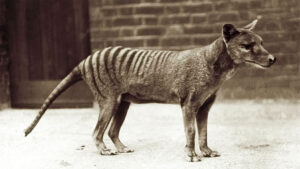#wolfdoguk #wolfdog #officialwolfdog
 Thylacines may have lived more like coyotes than like wolves, suggests a recent study, which looked at the extinct marsupial predator’s body size as a clue about its now-abandoned role in Tasmania’s ecosystem.
Thylacines may have lived more like coyotes than like wolves, suggests a recent study, which looked at the extinct marsupial predator’s body size as a clue about its now-abandoned role in Tasmania’s ecosystem.
Of all the animals that have gone extinct in the last century, thylacines may be among the most compelling. They looked like an impossible cross between a wolf and a small tiger, with striped hindquarters, long tails, and pointed ears.
The Thylacine (Thylacinus cynocephalus: dog-headed pouched-dog) is a large carnivorous marsupial now believed to be extinct. It was the only member of the family Thylacinidae to survive into modern times.
It is also known as the Tasmanian Tiger or Tasmanian Wolf.
The Thylacine was sandy yellowish-brown to grey in colour and had 15 to 20 distinct dark stripes across the back from shoulders to tail. Although the large head was dog- or wolf-like, the tail was stiff and the legs were relatively short. Body hair was dense, short and soft, to 15mm in length.
It had short ears (about 80 mm long) that were erect, rounded and covered with short fur. Jaws were large and powerful and there were 46 teeth. Adult male Thylacine were larger on average than females.
The female Thylacine had a back-opening pouch. The litter size was up to four and the young were dependent on the mother until at least half-grown. Interestingly, males also had a back-opening, partial pouch.
The Thylacine was mainly nocturnal or semi-nocturnal but was also out during the day. The animal moved at a slow pace, generally stiff in its movements. The Thylacine hunted singly or in pairs and mainly at night.
Thylacines preferred kangaroos and other marsupials, small rodents and birds. They were reported to have preyed on sheep and poultry after European colonisation, although the extent of this was almost certainly exaggerated. For example, a famous photo is now known to have been staged using a taxidermied Thylacine specimen with a dead chicken placed in its mouth.
Although the precise reasons for extinction of the Thylacine from mainland Australia are not known it appears to have declined as a result of competition with the Dingo and perhaps hunting pressure from humans. The Thylacine became extinct on the Australian mainland not less than 2000 years ago. Its decline and extinction in Tasmania was probably hastened by the introduction of dogs, but appears mainly due to direct human persecution as an alleged pest.
Aboriginal rock-paintings of Thylacine-like animals are recognised from northern Australia including the Kimberley region of Western Australia. They have also been found on walls or overhangs on exposed rock surfaces in the Upper East Alligator region of Deaf Adder Creek and Cadell River crossing in the Northern Territory.
There is evidence to suggest that Aboriginal people in Tasmania used the Thylacine as a food item.
source: australian museum

Last 3 Comments